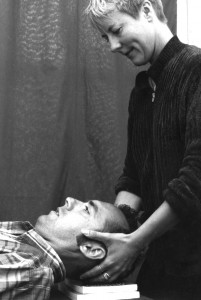Developed over 100 years ago by an Australian, F.M. Alexander, the Alexander Technique is now widely taught internationally by over 2500 teachers in schools, university faculties (especially the performing arts) and now the workplace, where extensive computer use has caused a universal increase in repetitive strain injuries. It is endorsed in both medical and scientific fields.
What is it?
The Alexander Technique addresses the cause of many chronic physical problems-poor postural habits. These affect our breathing and our efficiency of movement. Many therapies address symptoms and are very effective at eliminating pain, but often do not provide preventable guidelines or long-term solutions. Thus, after eliminating the pain, when one returns to the activity that caused the problem, if we haven’t changed our postural habits the same injury often reoccurs and becomes chronic.
The Technique is an education, and the students will often notice benefits including pain relief from the first few lessons.
- Learning how to change your postural habits.
- Finding a way to move, sit, drive or use a computer with less tension.
- Understanding how you can improve your co-ordination and apply it to speaking, playing sports or a musical instrument.
How is it taught?
- One-on-one in weekly 50 minute sessions. (20 to 25 lessons are usually enough)
- A highly trained teacher uses hands in a non-manipulative way with verbal instructions to make the person aware of how he or she can change.
- Lessons include table-work where the students lie fully clothed on a massage table
- Lessons can take place at your workstation, your gym, your home or my studio in North Beach.
Why take lessons?
- You may be mystified by your back pain, excess tension and lack of co-ordination and want to play a more proactive role in getting better.
- You might have a chronic physical problem you would like to solve, that you see as hereditary, structural or unchangeable.
- You may be unaware that how you move could be creating, or compounding your problem.
- You may not realize that how you go through your daily activities needlessly strains your joints and muscles.
What are the benefits?
- It enables you to handle daily stress and develop a long term solution to chronic pain and muscular tension.
- It can help prevent further injury and help recovery from chronic back, hip and neck disorders, traumatic or repetitive strain injuries, arthritis and muscular spasms.
- Athletes and dancers can improve strength, endurance and flexibility.
- Musicians, actors, public speakers and singers use it to lessen performance anxiety.
- Those in business find it enhances presentation skills and increases confidence.

